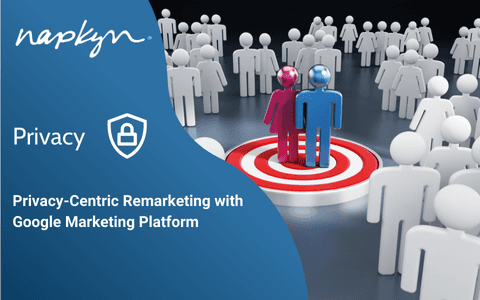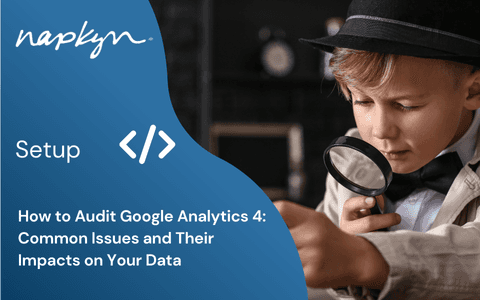

Remarketing in a Privacy-Centric World
Discover privacy-centric remarketing strategies with Google Marketing Platform. As third-party cookies fade, learn how to leverage Google’s privacy-first tools like Protected Audience API and Customer Match to engage your audience responsibly. Explore how GA4, BigQuery, and Google AI empower marketers to build compliant, effective remarketing campaigns that adapt to evolving privacy regulations and drive performance without compromising user trust.

Jasmine Libert
Senior Vice President, Data Solutions
"I like to think about this stuff in my free time. "
Privacy-centric remarketing with Google Marketing Platform
If you're still relying on third-party cookies to re-engage your audiences, you should be feeling a little nervous about the future of your digital marketing strategies (and possibly your job).
Remember the days when remarketing was as simple as following your potential customers around the internet, like a well-meaning (but slightly clingy) friend? Well, times have changed, and so has the tech. With privacy regulations tightening and third-party cookies becoming less reliable, marketers are left asking, "Now what?"
Luckily, remarketing isn’t dead; it’s just going through a bit of a makeover. With the evolution of digital marketing and the introduction of privacy-focused tools, there are new ways to engage audiences responsibly. The good news? Google Marketing Platform offers several solutions that not only adhere to privacy regulations, but also help advertisers achieve their performance goals. Let’s explore how you can stay ahead in this new era of remarketing, leveraging Google’s AI and privacy-preserving tools.
Start with Google Analytics
You’ve probably already started transitioning to more durable and privacy-centric marketing, whether you realize it or not (at least, hopefully!). It’s not just about adopting the right tools—although we’ll get to that. You also need to be prepared to make the most of the data you already have. That’s where Google Analytics comes into play. GA doesn’t just track what’s happening on your website, it can also help you to build privacy-safe audiences (assuming you have Consent Mode v2 enabled, if not, that’s a serious side-eye from me) that you can feed into Google’s ad platforms.
How does this work? You can use your first-party collected in GA to create robust audience segments based on user behaviour (your own, real-life customers!), website interactions or conversions. These audiences can then be leveraged in Google Ads for remarketing purposes, allowing you to re-engage with your customers (who opted in to tracking) in a compliant, privacy-conscious way.
But That’s Only the Beginning
Google Analytics is just a piece of the privacy-safe remarketing puzzle. For businesses looking to scale and further refine their first-party data asset, the real magic happens in BigQuery, a Google Cloud Platform tool designed for large-scale data analytics. By exporting your GA data into BigQuery, you can merge it with other sources of first-party data (CRM, call-centre, merchandise, finance, etc.), gaining deeper insights into customer behaviour and generating even more targeted and effective audiences (ask us how!).
Use The Power of Google Marketing Platform Tools (Without Being Creepy)
With third-party cookies on their way out (or at least becoming less reliable), marketers need to adapt quickly. Enter Google’s suite of privacy-safe tools, designed to help advertisers continue engaging with their audience while respecting user privacy. Here’s a breakdown of some must-try tools:
Protected Audience API: This solution allows you to continue re-engaging site visitors through the display network, but with signals that prioritize user privacy. It allows you to retarget users without accessing their personal info, instead, leveraging signals from browsers without relying on personally identifiable information.
Google-engaged Audiences in Google Ads (Beta): A privacy-preserving solution to re-engage users who have already interacted with your brand on Google’s surfaces like Search or YouTube. The data used is consented and Google-logged, making it a compliant way to reconnect with your audiences.
Customer Match + PAIR in DV360: Customer Match taps into your first-party data (that you have supercharged thanks to Google Analytics and BigQuery) to re-engage your audience across multiple channels. When paired with PAIR (a privacy-first clean room), you can scale your audience targeting across the DV360 display network.
Enhanced Automation & Optimized Targeting: Powered by Google AI, these tools help you maximize performance by leveraging advanced audience signals and AI models. Optimized Targeting, for example, helps you reach users you may not have otherwise identified.
Getting Comfortable with Change
Let’s be real: shifting from third-party cookies to these new tools can feel a bit daunting, especially if you’re used to simpler tracking methods. But that's exactly why continuous learning and adaptation are so important. In today’s privacy-conscious world, marketers need to stay informed, evolving their strategies in real time.
The key isn’t just knowing these tools exist—it’s embracing them, testing them, and refining your approach. Whether you’re armed with first-party data (and if not, Napkyn can help!), tapping into tools like Protected Audiences and Google AI will set you apart. Ignoring these innovations means falling behind, and no marketer wants that.
Next Steps: Keeping Your Remarketing Efforts Effective
So, what can you do today to get your remarketing strategy back on track?
Evaluate your current tactics: Are you still relying heavily on third-party cookies? It’s time to audit your current strategy and start incorporating privacy-safe alternatives.
Supercharge your first-party data asset: Combine your Google Analytics data with other datasets in BigQuery to generate privacy-safe and effective audiences.
Adopt durable solutions: Tools like Customer Match, Google-engaged audiences, and Protected Audience API allow you to continue targeting your audience in a respectful way, without the risk of violating privacy laws.
Harness Google AI: Tools like Enhanced Automation and Optimized Targeting help you get the most out of your data by tapping into AI-powered insights.
Adapt and evolve: Continuous learning is the name of the game. Keep an eye on the evolving landscape and ensure you’re regularly updating your strategies and audience approaches to stay compliant while maximizing your performance.
Keep evolving, or risk falling behind
Change might be inevitable, but that doesn’t mean your marketing performance has to suffer. With the right tools and mindset, you can thrive in this privacy-first era. Embrace tools like the Protected Audiences API, Customer Match, and Enhanced Automation to remarket smarter, not creepier.
Let’s keep those learning caps on, stay adaptable, and watch how modern, privacy-compliant marketing strategies can make a difference. Because, after all, isn’t it better to have customers love you for respecting their privacy than hate you for bombarding them with irrelevant ads?
More Insights


How to Audit Google Analytics 4 (GA4): Common Issues and Their Impacts on Your Data

Hasan Alanam
Manager, Data Solutions
Apr 7, 2025
Read More


How to move a GA4 property from one Google Analytics account to another

Trisha Patel
Senior Analyst, Data Solutions
Apr 2, 2025
Read More
More Insights
Sign Up For Our Newsletter

Napkyn Inc.
204-78 George Street, Ottawa, Ontario, K1N 5W1, Canada
Napkyn US
6 East 32nd Street, 9th Floor, New York, NY 10016, USA
212-247-0800 | info@napkyn.com

Remarketing in a Privacy-Centric World
Discover privacy-centric remarketing strategies with Google Marketing Platform. As third-party cookies fade, learn how to leverage Google’s privacy-first tools like Protected Audience API and Customer Match to engage your audience responsibly. Explore how GA4, BigQuery, and Google AI empower marketers to build compliant, effective remarketing campaigns that adapt to evolving privacy regulations and drive performance without compromising user trust.

Jasmine Libert
Senior Vice President, Data Solutions
"I like to think about this stuff in my free time. "
Privacy-centric remarketing with Google Marketing Platform
If you're still relying on third-party cookies to re-engage your audiences, you should be feeling a little nervous about the future of your digital marketing strategies (and possibly your job).
Remember the days when remarketing was as simple as following your potential customers around the internet, like a well-meaning (but slightly clingy) friend? Well, times have changed, and so has the tech. With privacy regulations tightening and third-party cookies becoming less reliable, marketers are left asking, "Now what?"
Luckily, remarketing isn’t dead; it’s just going through a bit of a makeover. With the evolution of digital marketing and the introduction of privacy-focused tools, there are new ways to engage audiences responsibly. The good news? Google Marketing Platform offers several solutions that not only adhere to privacy regulations, but also help advertisers achieve their performance goals. Let’s explore how you can stay ahead in this new era of remarketing, leveraging Google’s AI and privacy-preserving tools.
Start with Google Analytics
You’ve probably already started transitioning to more durable and privacy-centric marketing, whether you realize it or not (at least, hopefully!). It’s not just about adopting the right tools—although we’ll get to that. You also need to be prepared to make the most of the data you already have. That’s where Google Analytics comes into play. GA doesn’t just track what’s happening on your website, it can also help you to build privacy-safe audiences (assuming you have Consent Mode v2 enabled, if not, that’s a serious side-eye from me) that you can feed into Google’s ad platforms.
How does this work? You can use your first-party collected in GA to create robust audience segments based on user behaviour (your own, real-life customers!), website interactions or conversions. These audiences can then be leveraged in Google Ads for remarketing purposes, allowing you to re-engage with your customers (who opted in to tracking) in a compliant, privacy-conscious way.
But That’s Only the Beginning
Google Analytics is just a piece of the privacy-safe remarketing puzzle. For businesses looking to scale and further refine their first-party data asset, the real magic happens in BigQuery, a Google Cloud Platform tool designed for large-scale data analytics. By exporting your GA data into BigQuery, you can merge it with other sources of first-party data (CRM, call-centre, merchandise, finance, etc.), gaining deeper insights into customer behaviour and generating even more targeted and effective audiences (ask us how!).
Use The Power of Google Marketing Platform Tools (Without Being Creepy)
With third-party cookies on their way out (or at least becoming less reliable), marketers need to adapt quickly. Enter Google’s suite of privacy-safe tools, designed to help advertisers continue engaging with their audience while respecting user privacy. Here’s a breakdown of some must-try tools:
Protected Audience API: This solution allows you to continue re-engaging site visitors through the display network, but with signals that prioritize user privacy. It allows you to retarget users without accessing their personal info, instead, leveraging signals from browsers without relying on personally identifiable information.
Google-engaged Audiences in Google Ads (Beta): A privacy-preserving solution to re-engage users who have already interacted with your brand on Google’s surfaces like Search or YouTube. The data used is consented and Google-logged, making it a compliant way to reconnect with your audiences.
Customer Match + PAIR in DV360: Customer Match taps into your first-party data (that you have supercharged thanks to Google Analytics and BigQuery) to re-engage your audience across multiple channels. When paired with PAIR (a privacy-first clean room), you can scale your audience targeting across the DV360 display network.
Enhanced Automation & Optimized Targeting: Powered by Google AI, these tools help you maximize performance by leveraging advanced audience signals and AI models. Optimized Targeting, for example, helps you reach users you may not have otherwise identified.
Getting Comfortable with Change
Let’s be real: shifting from third-party cookies to these new tools can feel a bit daunting, especially if you’re used to simpler tracking methods. But that's exactly why continuous learning and adaptation are so important. In today’s privacy-conscious world, marketers need to stay informed, evolving their strategies in real time.
The key isn’t just knowing these tools exist—it’s embracing them, testing them, and refining your approach. Whether you’re armed with first-party data (and if not, Napkyn can help!), tapping into tools like Protected Audiences and Google AI will set you apart. Ignoring these innovations means falling behind, and no marketer wants that.
Next Steps: Keeping Your Remarketing Efforts Effective
So, what can you do today to get your remarketing strategy back on track?
Evaluate your current tactics: Are you still relying heavily on third-party cookies? It’s time to audit your current strategy and start incorporating privacy-safe alternatives.
Supercharge your first-party data asset: Combine your Google Analytics data with other datasets in BigQuery to generate privacy-safe and effective audiences.
Adopt durable solutions: Tools like Customer Match, Google-engaged audiences, and Protected Audience API allow you to continue targeting your audience in a respectful way, without the risk of violating privacy laws.
Harness Google AI: Tools like Enhanced Automation and Optimized Targeting help you get the most out of your data by tapping into AI-powered insights.
Adapt and evolve: Continuous learning is the name of the game. Keep an eye on the evolving landscape and ensure you’re regularly updating your strategies and audience approaches to stay compliant while maximizing your performance.
Keep evolving, or risk falling behind
Change might be inevitable, but that doesn’t mean your marketing performance has to suffer. With the right tools and mindset, you can thrive in this privacy-first era. Embrace tools like the Protected Audiences API, Customer Match, and Enhanced Automation to remarket smarter, not creepier.
Let’s keep those learning caps on, stay adaptable, and watch how modern, privacy-compliant marketing strategies can make a difference. Because, after all, isn’t it better to have customers love you for respecting their privacy than hate you for bombarding them with irrelevant ads?
More Insights

How to Set Up GA4 Ecommerce Tracking (Without Data Loss) | A Complete Step-by-Step Guide

Ricardo Cristofolini
Senior Implementation Specialist, Data Solutions
Apr 16, 2025
Read More

Integrating Google Analytics, Salesforce, and Google Ads for Marketing Superpowers

Monika Boldak
Associate Director, Marketing
Apr 9, 2025
Read More

How to Audit Google Analytics 4 (GA4): Common Issues and Their Impacts on Your Data

Hasan Alanam
Manager, Data Solutions
Apr 7, 2025
Read More
More Insights
Sign Up For Our Newsletter


